
Seismic Instruments
Scope & Guideline
Connecting researchers to the forefront of geophysical instrumentation.
Introduction
Aims and Scopes
- Seismic Monitoring and Instrumentation:
Research focusing on the development, application, and assessment of various seismic monitoring instruments and networks, including innovative technologies for real-time data acquisition. - Seismic Hazard Assessment:
Studies assessing seismic hazards, including probabilistic and deterministic approaches, to evaluate risks and impacts on structures and populations in various geographical regions. - Geophysical Investigations:
Exploration of subsurface structures and properties using seismic, electromagnetic, and gravimetric methods, aimed at understanding geological formations and their seismic responses. - Paleoseismology and Historical Seismicity:
Investigation of historical earthquakes and paleoseismic records to uncover patterns of seismic activity and improve understanding of long-term seismic hazards. - Seismic Data Analysis and Modeling:
Analysis of seismic data through advanced statistical methods and modeling techniques to interpret seismic events, ground motion, and related geophysical phenomena. - Environmental and Engineering Seismology:
Research addressing the effects of seismic activity on the built environment, including structural responses, site effects, and the evaluation of construction materials and methods.
Trending and Emerging
- Distributed Acoustic Sensing (DAS):
The adoption of DAS technology is on the rise, enabling high-resolution seismic monitoring over large areas, which is transforming the field of seismic data collection and analysis. - Integration of Multi-Disciplinary Approaches:
An increasing trend towards integrating various geophysical methods (e.g., seismic, electromagnetic, and gravimetric) to provide comprehensive assessments of seismic hazards and geological conditions. - Real-Time Seismic Data Processing and Automation:
Advancements in software and algorithms for the automated processing of seismic data are gaining attention, enhancing the efficiency and accuracy of seismic monitoring. - Impact of Climate Change on Seismicity:
Research exploring the potential influences of climate change on seismic activity and related geological processes is emerging, highlighting the need for interdisciplinary studies. - Seismic Effects of Anthropogenic Activities:
There is a growing interest in understanding how human activities, such as mining and construction, impact seismicity and ground stability, reflecting broader environmental concerns.
Declining or Waning
- Historical Seismology of Lesser-Known Regions:
Research focused on historical seismic events in less-studied areas has decreased, possibly indicating a shift towards more contemporary seismic activities and advanced methodologies. - Basic Seismological Theory without Applications:
There is a noticeable reduction in publications that solely discuss foundational theories of seismology without practical applications, as researchers increasingly seek to link theory with real-world applications. - Traditional Seismic Measurement Techniques:
The use and exploration of traditional seismic measurement techniques appear to be waning, as new technologies such as distributed acoustic sensing gain traction. - Localized Case Studies:
While specific case studies remain important, there has been a trend towards broader, comparative studies that encompass multiple regions or phenomena, leading to a decrease in isolated case studies.
Similar Journals

Applied Geophysics
Empowering Research Through Interdisciplinary CollaborationApplied Geophysics is a premier journal dedicated to the interdisciplinary study of geophysical processes and their applications across various domains, published by SPRINGER. With an ISSN of 1672-7975 and an E-ISSN of 1993-0658, this journal serves as a pivotal platform for researchers, professionals, and students to share their latest findings and insights in the field of geophysics. Operating from China, the journal has established itself within the Q3 quartile in Geophysics as of 2023, reflecting its commitment to high-quality research, even as it ranks #105 out of 165 in the Earth and Planetary Sciences category, placing it in the 36th percentile on Scopus rankings. This makes it an essential resource for advancing knowledge in geophysical methodologies and applications. While it operates in a traditional subscription model, its relevance and timeliness ensure it remains a crucial outlet for emerging scientific discussions. The journal particularly encourages the integration of practical applications with theoretical frameworks, fostering innovation in areas such as environmental geophysics, resource exploration, and hazard assessment.
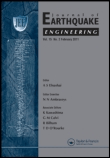
JOURNAL OF EARTHQUAKE ENGINEERING
Shaping the future of earthquake-resistant design.JOURNAL OF EARTHQUAKE ENGINEERING, published by TAYLOR & FRANCIS LTD, stands as a pivotal resource in the fields of Building and Construction, Civil and Structural Engineering, and Geotechnical Engineering. With an impressive Q1 ranking in multiple categories for 2023, this journal is instrumental for researchers, professionals, and students committed to advancing knowledge in earthquake engineering and its practical applications. As a platform that spans the years from 1997 to 2024, it highlights significant contributions to safety, risk, reliability, and quality in engineering practices. While the journal operates on a subscription basis, its highly regarded articles, bolstered by robust Scopus rankings—such as rank #46 in Building and Construction—underscore its credibility and influence in shaping standards and methodologies within the discipline. Promoting innovative and evidence-based approaches, the JOURNAL OF EARTHQUAKE ENGINEERING is essential reading for anyone engaged in the science and technology of earthquake-resistant structures.
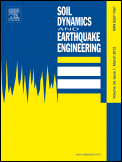
SOIL DYNAMICS AND EARTHQUAKE ENGINEERING
Exploring the Foundations of Seismic Safety and Soil BehaviorSOIL DYNAMICS AND EARTHQUAKE ENGINEERING is a premier academic journal published by ELSEVIER SCI LTD, focusing on the intersection of civil and structural engineering, geotechnical engineering, and soil science. Since its inception in 1986, the journal has established itself as a critical resource for advancing knowledge in these fields over nearly four decades, with a remarkable Q1 ranking in 2023 across multiple categories, including Civil and Structural Engineering, Geotechnical Engineering, and Soil Science. The journal’s impactful research, reflected in its high Scopus ranks, serves as a vital reference for both professionals and academics dedicated to understanding soil dynamics and mitigating earthquake hazards. Although it currently does not offer open access, the journal's rigorous peer-review process ensures that published articles provide substantial contributions to the understanding of soil behavior under seismic conditions. Whether you are a researcher, a practitioner, or a student, SOIL DYNAMICS AND EARTHQUAKE ENGINEERING offers essential insights and innovative methodologies pivotal for advancing your work in soil dynamics and earthquake engineering.
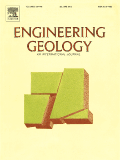
ENGINEERING GEOLOGY
Transforming Geological Principles into Engineering PracticesENGINEERING GEOLOGY, published by Elsevier, is a leading journal in the fields of Geology and Geotechnical Engineering, recognized by its prestigious Q1 ranking in both categories for 2023. With a deep focus on the application of geological principles to engineering practices, this journal plays a vital role in advancing knowledge and methodologies that enhance infrastructure development and environmental sustainability. Operating since 1965, the journal disseminates high-quality research, offering insights that foster innovation in geotechnical assessments and geological hazard evaluation. Researchers and professionals benefit from its rigorous peer-review process and impactful studies, bolstered by a strong Scopus ranking - #4 in Geology and #3 in Geotechnical Engineering, both placing it in the top 2% of its field. Although there is no Open Access option available, the journal facilitates significant academic discourse, making it an essential resource for anyone involved in the intersection of geology and engineering.
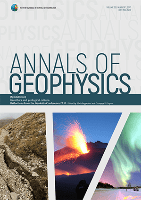
ANNALS OF GEOPHYSICS
Unlocking the Secrets of Our Planet's DynamicsANNALS OF GEOPHYSICS is a prestigious open access journal dedicated to the advancement and dissemination of research in the field of geophysics. Published by the IST NAZIONALE DI GEOFISICA E VULCANOLOGIA in Italy, this journal has embraced open access since its inception in 1948, promoting wide accessibility to cutting-edge research. With an impressive Scopus ranking, placing it in the 52nd percentile within Earth and Planetary Sciences for the category of Geophysics, the journal serves as a vital platform for scholars, researchers, and practitioners seeking to explore the intricate phenomena of our planet. Covering a diverse range of topics in the geophysical community, the ANNALS OF GEOPHYSICS invites contributions that push the boundaries of our knowledge and understanding of geophysical processes, aiding in the development of innovative solutions to urgent environmental challenges. Published continuously from 2002 to 2024, the journal’s commitment to quality and rigor is reflected in its Q3 quartile ranking for 2023, making it a notable resource for the academic community.
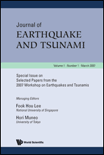
Journal of Earthquake and Tsunami
Navigating the complexities of seismic activity and ocean waves.Welcome to the Journal of Earthquake and Tsunami, a premier scholarly publication dedicated to advancing the field of geophysical research, with a particular focus on seismic activity and tsunami phenomena. Published by World Scientific Publishing Co Pte Ltd, this journal provides a vibrant platform for researchers and practitioners alike to share their findings and innovations, contributing to the global understanding of these critical natural events. With an impact factor that reflects its relevance, the journal is categorized in Q3 quartiles for 2023 in areas including Geophysics, Geotechnical Engineering, and Oceanography, indicating a solid standing in the scientific community. It is indexed within Scopus, ranking in the upper half of its categories, which further establishes its importance as a resource for students and professionals seeking to stay informed about the latest developments. Although the journal operates under a traditional access model, its commitment to fostering scholarly discourse remains unwavering. Founded in 2008 and set to converge its offerings until 2024, the Journal of Earthquake and Tsunami continues to be an invaluable resource for anyone dedicated to understanding the dynamic and often dangerous interactions of our planet’s geological features.

Quaderni di Geofisica
Exploring the Depths of Geophysical PhenomenaQuaderni di Geofisica is a distinguished academic journal published by the IST NAZIONALE GEOFISICA & VULCANOLOGIA-INGV in Italy, focusing on pivotal areas within the fields of geophysics, geology, and computer applications in Earth sciences. Since its inception, this journal has served as a vital platform for the dissemination of innovative research and methodologies, advancing our understanding of geophysical phenomena and their implications. The journal spans various converged years from 2007 to 2019 and 2021 to 2024, allowing for a comprehensive examination of contemporary developments in the field. Despite being categorized in Q3 and Q4 quartiles by Scopus, it plays a critical role in bridging the gap between theory and practice for researchers, professionals, and students alike. The journal's commitment to fostering scholarly communication is underscored by its strategic focus on multidisciplinary studies, making it an essential resource for those engaged in Earth sciences research. Readers can access the journal's content through institutional libraries or by direct request, ensuring a broad reach and ongoing contribution to the global scientific community.

JOURNAL OF SEISMOLOGY
Unveiling the secrets of Earth's seismic activities.Welcome to the JOURNAL OF SEISMOLOGY, an esteemed publication in the field of Earth sciences, dedicated to the study of seismic phenomena and their implications on geophysical and geochemical processes. Published by SPRINGER and based in the Netherlands, this journal has been contributing to the academic community since 1997 and is set to continue through 2024. With an impressive ranking within the quartiles—Q2 in Geophysics and Q3 in Geochemistry and Petrology for 2023—this journal is a pivotal resource for researchers and professionals seeking to expand their understanding of seismic activities, earthquake mechanics, and related geological interactions. Despite not offering open access, it remains a highly regarded platform for disseminating rigorous research and findings in Earth and Planetary Sciences, sustaining a global readership keen on advancing their knowledge in this dynamic field. The JOURNAL OF SEISMOLOGY is committed to fostering scholarly exchange and advancing scientific inquiry, making it an invaluable asset for students, researchers, and professionals alike.

Ingegneria Sismica
Connecting researchers to enhance earthquake engineering insights.Ingegneria Sismica, a premier journal published by PATRON EDITORE S R L, serves as an essential platform for the dissemination of research in the fields of building and construction, geotechnical engineering, and safety risk management. With a focus on earthquake engineering and structural safety, the journal has established itself as a prominent source of knowledge since its inception in 2010. The journal holds an impressive Q2 classification in multiple categories, including Building and Construction and Geotechnical Engineering, reflecting its significant impact within these disciplines. Despite its Italian roots, it appeals to an international audience of researchers, professionals, and students dedicated to advancing the understanding of seismic resilience and risk mitigation strategies. Although open access is not currently available, the potential for knowledge sharing and innovative methodologies presented in the articles continues to attract a robust readership. With its commitment to excellence and relevance, Ingegneria Sismica is poised to shape future discourse in engineering practices aimed at enhancing safety, reliability, and quality within seismic zones.
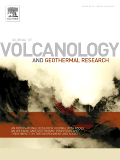
JOURNAL OF VOLCANOLOGY AND GEOTHERMAL RESEARCH
Exploring the Dynamics of Earth’s Fiery HeartWelcome to the Journal of Volcanology and Geothermal Research, a premier publication dedicated to advancing the understanding of volcanic and geothermal processes. Published by Elsevier in the Netherlands, this esteemed journal holds a distinguished Q1 ranking in both Geochemistry and Petrology and Geophysics, reflecting its influential contribution to the field. Since its inception in 1976, the journal has served as a critical platform for high-quality research, disseminating cutting-edge findings that shape the discourse surrounding Earth sciences. With an impressive Scopus ranking—27th in Geophysics and 43rd in Geochemistry and Petrology—scholars and practitioners alike regard it as an essential resource for staying informed on the latest research trends. Although it does not provide open access options, the journal remains committed to enriching the academic community's understanding of geothermal energy, volcanic hazards, and related geophysical phenomena, making it a must-read for anyone invested in these dynamic fields.